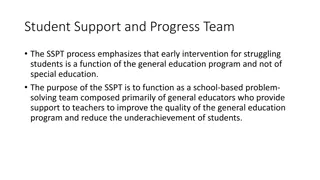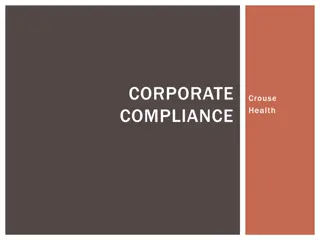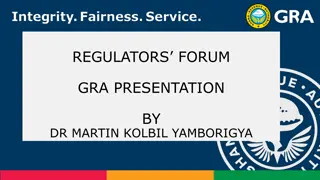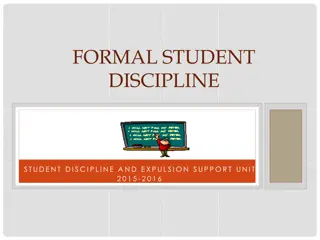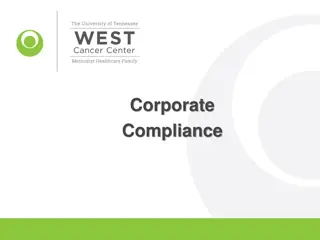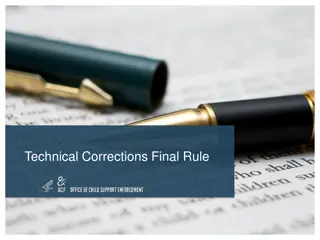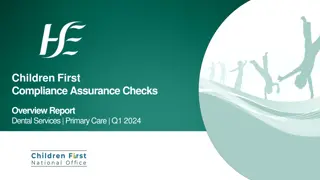Student Support and Compliance
Identify off-grid students, evaluate needs, refer for services, avoid common mistakes, form evaluation teams for proper placement in school.
Download Presentation

Please find below an Image/Link to download the presentation.
The content on the website is provided AS IS for your information and personal use only. It may not be sold, licensed, or shared on other websites without obtaining consent from the author.If you encounter any issues during the download, it is possible that the publisher has removed the file from their server.
You are allowed to download the files provided on this website for personal or commercial use, subject to the condition that they are used lawfully. All files are the property of their respective owners.
The content on the website is provided AS IS for your information and personal use only. It may not be sold, licensed, or shared on other websites without obtaining consent from the author.
E N D
Presentation Transcript
SECTION 504 COMPLIANCE Federal Civil Rights Rehabilitation Act of 1973 Americans with Disabilities Act of 1990 ADA Amendments Act of 2008
1. Child-find (where are they?) 2. Evaluation (what does the data say?) 3. Eligibility Determination (are they in?) 4. Section 504 Plan (what accommodations) 5. Periodic Reevaluation (at least every 3 yrs.) 6. Procedural Safeguards (parent rights) 7. Records (how long kept and where?) 504 BASICS
LOCATE 1. IDENTIFY CHILD FIND EVALUATE
Who are the students that are off grid? Who are the students that are struggling the most? SUSPECTED OF HAVING A DISABILITY WITHIN BOUNDARIES Who are being referred for discipline? Who are being considered for retention? Who has had a serious injury or illness? Who exhibits signs of depression, anxiety or other mental health conditions? Who was evaluated but did not qualify for Special Education?
Excluding Excluding students who get good grades Excluding Excluding students who have episodic conditions, (ex.: migraines, seasonal allergies, remission, etc.) COMMON MISTAKES Wait & See Rigidly insisting on implementing all tiers of RIT
REFERRAL https://www.washk12.org/ima ges/departments/student_ser vices/504/section504referral. pdf Who may and should complete a referral? Parent School Personnel (administrator, counselor, teacher) Any person who has knowledge
THE RECOMMENDED COMMITTEE/TEAM: School 504 Coordinator Administrator (could be the same as above) Counselor Parent (not required but!) Teacher School Nurse (or healthcare person) Psychologist Student 2. EVALUATION A group, at least 3 people, who are knowledgeable about the student and the data
MUST EVALUATE PRIOR TO INITIAL PLACEMENT
Consent Form Link MUST HAVE CONSENT
RTI teams are a great source for child find. RESPONSE TO INTERVENTION However, during an evaluation, RTI is most safely applied with students who: Don t delay based upon RTI Have no known disability Exhibit academic difficulties
Evaluation focused on review and consideration of various sources of relevant data (34 CFR 104.35(c)) General evaluation model for 504 may not include new testing DATA Gather evidence and use existing data sources
Aptitude and achievement tests and grades Teacher/staff observations and recommendations Physical condition MULTIPLE SOURCES REQUIRED Social/cultural background and adaptive behavior Discipline and attendance logs Parent input Healthcare provider reports
https://www.washk12.org/ima ges/departments/student_ser vices/504/section504parentgu ardianinput.pdf PARENT IS A GREAT SOURCE
A doctors report is not a 504 evaluation. Vineland (CA) Elementary School District, 49 IDELR 20 (OCR 2007). MEDICAL DATA A physician s medical diagnosis may be considered as part of the evaluation process. However, a medical diagnosis of an illness does not automatically qualify a student for services under Section 504.
Diagnosis of ADHD requires a comprehensive evaluation by a licensed clinician, such as a pediatrician, psychologist, or psychiatrist with expertise in ADHD. (National Institutes of Mental Health 2016) Dear Colleague Resource Guide on Students with ADHD & Section 504 (2016): school districts could discover necessary and helpful information from the student, the student s parents and professionals, such as psychologists and physicians. MEDICAL DATA AND ADHD Although the district could request relevant information from parents, the district cannot require the parent to provide certain data or information... It is the district s obligation to evaluate; it cannot shift the burden of that cost or obligation onto the parent.
DIAGNOSIS AS A PART OF EVALUATION DATA (Teams identify impairments not diagnose) https://www.washk12.org/ima ges/departments/student_ser vices/504/section504physicia nsinput.pdf
Does the evaluation show: (1)Physical or mental impairments that 3. ELIGIBILITY (2) Substantially limits one or more major life activities or major bodily functions.
Any physiological disorder/condition or cosmetic disfigurement, or anatomical loss affecting one or more of the following body systems: PHYSICAL OR MENTAL neurological; musculoskeletal; special sense organs; respiratory, including speech organs; cardiovascular; reproductive; digestive; genito- urinary; hemic and lymphatic; skin; and endocrine; or IMPAIRMENT any mental or psychological disorder, such as mental retardation, organic brain syndrome, emotional or mental illness, and specific learning disabilities.
Any impairment which makes a major life activity more difficult or burdensome than for the average population of same age SUBSTANTIALLY LIMITS
MAJOR LIFE ACTIVITIES OR MAJOR BODILY FUNCTIONS 34 C.F.R. 104.3(j)(2)(ii) Major life activities (pre-2008) include functions such as caring for oneself, performing manual tasks, walking, seeing, hearing, speaking, breathing, learning, and working Congress 2008 additional examples of general activities that are major life activities, including eating, sleeping, standing, lifting, bending, reading, concentrating, thinking, and communicating. Congress non-exhaustive list of examples of major bodily functions that are major life activities, such as the functions of the immune system, normal cell growth, digestive, bowel, bladder, neurological, brain, respiratory, circulatory, endocrine, and reproductive functions.
MITIGATING MEASURES
Dyslexia COMMON 504 CONDITIONS Chronic health conditions Diabetes* Severe food allergies (IF NOT ELIGIBLE UNDER IDEA DUE TO SEVERITY AND NEED) ADD, ADHD Psychological conditions (bipolar*) Epilepsy* Fetal Alcohol Syndrome Traumatic brain injury Autism*
Meeting the needs of 504 students as adequately as the needs of nondisabled peers 4. (34 CFR 104.33(b)) THE 504 PLAN An equal educational opportunity standard Reduce the impact of the impairment to level the playing field No guarantee of result or maximization
BUILD UPON: DATA: Understand the impairment and its impact. What is the condition & how does it interfere? NEEDS: Compared to the non-disabled peer what does the student need to have the same opportunity? ACCOMMODATIONS: Developed (or changed) by the 504 committee and must not alter the underlying course content
Environmental strategies make adjustments to the student s environment. Organizational strategies make adjustments to lessons, assignments and testing. Behavior strategies make behavior modification adjustments for student. HELPFUL STRATEGIES Presentation strategies make adjustments to how information is presented to the student. Methodology strategies make adjustments to the instructional methods and pace. Curriculum strategies make adjustment to the amount, type and presentation of material.
ACCOMMODATIONS & MODIFICATIONS Separate space for different tasks Provide an extra set of textbooks for home use Adjust student seating Use study guides and organizing tools Provide a peer tutor/helper Provide recorded books Provide school counseling Provide behavioral reinforcement Provide untimed tests or oral tests Have the student use an organizer Train in organizational skills Use small group instruction Provide oral testing Spellchecker Calculator Modify recess/PE/transportation Modification involving Policy (ex: Attendance, Wellness food in the classroom) Accommodations: Changes how a student learns the material Modifications: Changes what a student is taught or expected to do or learn
ADHD Scenario 1needs only organizational aids, behavioral interventions, extra time, preferential seating, some counseling = 504 DISABILITY/ ELIGIBILITY SPECTRUM ADHD Scenario 2 Significantly below grade level, needs organizational aids, FBA/BSP (significant behavior issues), accommodations, and inclusion sped instructional assistance in two core academic areas = IDEA
Allergy to peanuts: The likelihood of exposure is pretty high. Duty to control the environment and adhere to the Individual Healthcare Plan & Emergency Plan. However, cannot guarantee peanut free . LEGAL OBLIGATION TO KEEP STUDENT SAFE Compare how safe they are to non-disabled students who do not regularly face life threatening reactions to their environment. However, they may get injured on the playground. Remote possibilities exist.
Examples: Student has diabetes and receives glucose testing and insulin administration during his school day and he wants to participate in the after-school theater group The school would need to provide the same aids and services for the student after- school as during the school day. Student has a hearing impairment and qualified for track team. The coach provides visual cues to simultaneously signal the start of the race. EQUAL OPPORTUNITY TO PARTICIPATE IN EXTRA- CURRICULAR
Services not limited to low-cost or free The accommodation doesn t have to be the best, just appropriate to meet the need. SERVICES Rather than direct services provided by the service provider, consider training an adult at the school, or on the bus to carry out the service Funding: Nothing specific - General Funding Source
Transfer students within District honor the Plan. Transfer student out of District provide comparable Plan & get together as a team as soon as possible to re-evaluate the Plan. PLANS FOR NEW OR VIRTUAL STUDENTS Some accommodations are only applicable at school; however, some online students may need portions of their Plan such as, extra support, tech tutorials, more communication, follow-up on assignments, virtual instruction, etc.
HEALTHCARE PLANS Most students on health plans may need to be made 504-eligible, according to OCR, so that they have access to 504 process and safeguards (OCR 2012 Dear Colleague Letter, at question 13)
When evaluating whether a district has failed to provide the related aids and services deemed necessary to provide the student a FAPE, OCR determines: whether the placements, aids, and services identified by the district through this process as necessary to meet the student's individual needs were or are being provided. IMPLEMENTING THE PLAN If they have not been provided, OCR will determine the district's reason for failing to do so and the impact of the failure.
DO WHAT YOU SAID YOU WOULD Give every person responsible for implementing the Plan a copy of the Plan!! Review the Plan with all relevant staff, obtain signature to indicate that they understand their responsibility in following the Plan. 504 School Coordinator periodically check with those responsible to see how the student is doing - DOCUMENT
SECTION 504 NOTICE OF DECISION AND ACCOMMODATION PLAN https://www.washk1 2.org/images/depart ments/student_servi ces/504/section504n oticedecisionaccom modations.pdf
Only required to review and reevaluate periodically - every three years .5 Annual review of the Plan is best practice but not required PERIODIC REVIEW Anytime the condition changes reconvene and review the Plan (but not more than once a year unless parent and school agree) When a schedule change occurs, review with the new teacher(s)
Basic rights: Notice before an action, evaluation by a team using a variety of sources, may refuse consent, right to due process, representation, review of records, complaint, including OCR. 6. PROCEDURAL SAFEGUARDS https://www.washk12.org/images/ departments/student_services/504 /yourrightsundersection504- final_ada-copy.pdf
https://www.washk12.or g/images/departments/ student_services/504/se ction504dueprocesshear ing.pdf DUE PROCESS
Disciplinary removals >10 consecutive school days must conduct a Manifestation Determination Review Exception: Current alcohol or drug use/violation lose right to MDR, and right to a hearing MANIFESTATION DETERMINATION https://www.washk12.org/images/departments/stud ent_services/504/section504manifestationdetermina tion.pdf
Student moved out of District: Retain for 3 years after transfer 7. Received a request for the 504 Plan: Send a copy separately (like an IEP) RECORDS Maintain 504 Plan/records in the cumulative file for 3 years after graduation.
"No otherwise qualified individual with a disability in the United States . . . shall, solely by reason of her or his disability, be excluded from the participation in, be denied the benefits of, or be subjected to discrimination under any program or activity. . . ." 504 FOCUS NON- DISCRIMINATION
Additional Resources: OCR Frequently Asked Questions About Section 504 Thank you! Section 504 Compliance Conference Spring 2021 Jose Martin & Dave Richards




